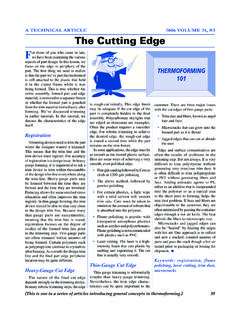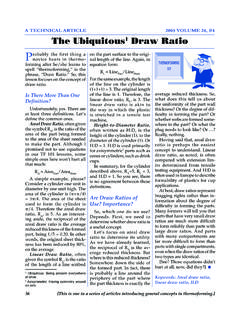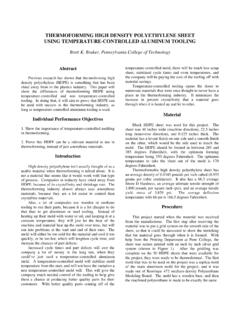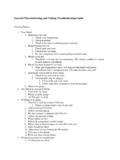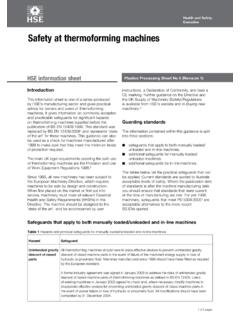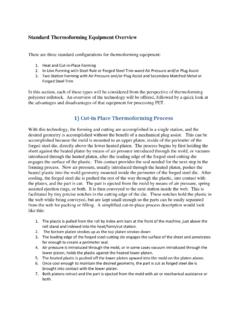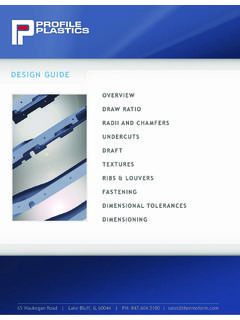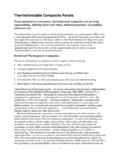Transcription of AHISTORYOF*THE GROWTHOF*THE …
1 PLASTIMACH CORP. A HISTORY OF THE GROWTH OF THE thermoforming INDUSTRY Chapter I thermoforming Pioneers 1930- 1950 Stanley R. Rosen 702-869-0840 Early experiments which led up to the commercialization of thermoforming techniques. 2 Chapter 1 thermoforming PIONEERS 1930-1950 The development of modern machinery for the thermoforming industry took place on the shoulders of very perceptive pioneers during the years 1930-1950. These experimenters did not have our modern tools or hindsight yet they developed many of the processes we currently employ.
2 Information contained in this article was abstracted from periodicals, patents, and conversations with industry innovators. Other firms may have developed proprietary equipment to thermoform during this period. A great deal of development effort pre-World War II went into forming airplane acrylic canopies free of flaws. E. L. Helwig of Rohm and Haas Company in Philadelphia, an acrylic resin manufacturer, has two patents using different techniques which when modified are used today. 3 Helwig s patent filed on 11-27-1938 illustrates the forming of a canopy from a pre-heated sheet of acrylic forming which utilizes a hot fluid under variable pressure.
3 The mold was water cooled so that sheet surface facing the cavity would chill and become hard enough to avoid being marred against the mold surface. The inner surface sheet would be free of blemishes since it only has contact with the hot fluid. This process is similar to a modified method used today where air pressure forms sheet against a temperature-controlled mold producing high quality parts. Helwig patent filed on 8-28-1942 describes a male snap-back technique using an oven-heated acrylic sheet which is clamped to the device with quick-acting clamps or bolts. 4 Figs. 1-2 Illustrated the use of vacuum to pre-stretch the hot sheet and then allows atmospheric pressure to force the hot plastic against the male cavity.
4 Figs. 3-4 Air pressure creates a bubble of hot plastic which, after the air is exhausted from the chamber, the plastic sheet then snaps back to the cavity. The expansion of the surface of the hot sheet before forming is utilized to assist in producing uniform wall thickness on the finished part. This process appears to be the first patent in which a male cavity is thermoformed. 5 R. E. Leary of Dupont Corp. patent filed 12-27-1940 illustrates vacuum forming using two methods of controlling a radiant heat source to achieve a uniform wall thickness. 6 The heater assembly can be raised or lowered relative to the plastic sheet line.
5 Moving a heat source away from or toward the sheet is a powerful method of heat control. The distance of a radiant source to its receptor is not a linear function and a small movement can create big differences in temperature distribution across a sheet surface. Each lamp in the heater assembly is individually controlled so that the heating pattern can be zoned to promote a uniform temperature distribution across the sheet. This patent suggests the use of radiant heating at the forming site rather than preheating the sheets in an oven and later transporting them to a mold. J. J. Braund patent filled on 2-17-1936 is not a plastics patent but it has an interesting concept.
6 Braund in the early 1930s started to develop a process to produce inexpensive three-dimensional relief maps for the Coast and Geological Survey. 7 A relief map copper sheet is distortion printed with each color referring to a specific elevation. When formed, the map might use green for sea level at the sheet line and white for the tips of the mountains in the deepest part of the female mold. This technique registers a pre-printed sheet of ductile metal facing a female mold mounted above the blank. The back face of the sheet is sealed to a shallow box and the whole assembly is locked within a clamp frame.
7 Hydraulic oil under high pressure is pumped into the box, forcing the metal sheet to flow into the mold. If the date of the above patent was 1946 instead of 1936, Braund would have been able to substitute a plastic sheet instead of metal and use air instead of oil pressure. 8 J. J. Braund filed a patent on 9-24-1946 which describes a system for vacuum forming plastic relief maps similar to his earlier 1936 metal forming methods. 9 This sheet heating system is analogous to R. E. Leary s radiant heat oven, except the heater fan provides convection heat transfer rather than radiant heating.
8 The top fan creates an air flow through the bank of heat lamps which increases the air temperature within the hood and heats the plastic to forming temperature. Braund claims this method creates a uniform sheet temperature for accurate registration of pre-printed sheet to vacuum forming mold. F. E. Wiley of Plax Corp., Hartford, Connecticut, filed for a patent on 6-1-1944 concerned with forming techniques which produce a uniform wall thickness on deep drawn parts. 10 This system is a three-step process in which the sheet is pre-heated, and in the second step is to form to a shallow depth in a female cavity.
9 A third operation draws the sheet to the deeper finished size on the male cavity. The heating medium is steam, which raises the sheet to forming temperature in all the steps and the clamp which holds the pre-heated sheet frame is moved manually from step to step. Wiley has developed four similar variations of this technique. (Only one is illustrated as follows:) ( ) is a steam heating chamber. In a shallow female mold and sheet is heated and pressure-formed using steam and the part wall thickness is at a minimum at the bottom (20a) and thickest at the sidewall (20b). In the formed shot is steam-reheated and male cavity (31a) is extended into the shallow plastic formed part to stretch the part to full depth.
10 After the male cavity is fully extended the steam is exhausted and the cavity (31a) reaches its final depth, the cooling cycle commences. The male cavity draws material from the upper side wall (20d) and very little from the tip (20a) which results in a fairly uniform wall thickness 11 ( ). G. W. Borkland of Borkland Lab, Marion, Indiana filled a patent on 10-2-1941 for forming a plastic lighting diffuser. 12 A heated plastic sheet is held in a removable clamp frame above a box to which is fastened a soft thick sponge rubber membrane. The male cavity is mounted on an upper moving platen.
